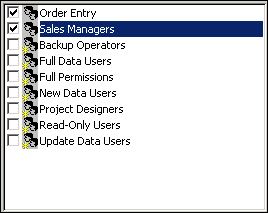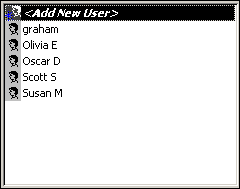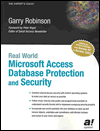databasedev.co.uk - database solutions and downloads for microsoft access
Microsoft Access Articles
- General Microsoft Access Articles
- Microsoft Access 2007 Articles
- Tables
- Queries
- SQL
- Forms
- Reports
- Macros
- Modules & VBA
- Data Models
- Downloads
GUI Design
Resources
Online Shop
Info
Web
2.0-like User-Level Menus in Access
UI Builder for Microsoft Access offers user-level menus out of the
box. Limit users to specific forms and reports in your database without
implementing Access workgroup security. UI Builder is packed with
features to enhance any multi-user database. Download a free
trial today.
Microsoft Access Database Security
The Security Wizard:
The Admin user owns all the objects in the database and has irrevocable permissions to them. However, it is important to change the ownership to the project leader’s account (you). When you create or copy an object, the user who is logged in becomes the owner. The easiest way to change ownership of all objects in the database is to first make sure your project leader is logged in, and then run the Security Wizard.
You can use the Security Wizard to create a new database and fill it with copies of the objects of the database that is currently open. The Security Wizard exports copies of all the objects from the original database. It also secures selected object types by revoking all permissions in the Users group for those objects in the database. The new database is encrypted, which means that it is indecipherable during electronic transmission or when it is stored on a disk, tape, or other magnetic medium. All table relationships and linked tables are recreated in the new database. However, the original database is not changed.
Changing the Ownership of Database Objects
An object's owner is the user who creates that object, also known as the object's creator. The owner of an object has Administer permissions. Other users cannot change the object owner's permissions. If another user creates a new object in the database, then that user is the owner of the object. Having different owners for all the objects within a database can be cumbersome. The database will be easier to maintain if one user is designated as the owner and takes responsibility for maintaining the objects. You can change the owner of an object by using the Change Owner tab of the User and Group Permissions dialog box.
Now let's use the Security Wizard to create an unsecured backup copy of the sample Microsoft Access database download file: MyNewApp.mdb and to secure MyNewApp.mdb. You should have already completed the previous tutorials within this security section; details of each can be found at the bottom of this page.
Task A-6: Using the Microsoft Access Security Wizard
Objective: To create a new database that only certain users can access. This information relates to the sample Microsoft Access database download
- Exit Access. Start Access
- Open MyNewApp.mdb. In the Logon dialog box, enter your password and click OK.
- Choose Tools, Security, User And Group Permissions.
- Select the Change Owner tab. The form objects
are displayed. Notice that Admin is the owner of every form. Display
different object types from the Object Type drop-down list. Admin
is the owner of every object type.

- Click Cancel to dismiss the dialog box.
- Choose Tools, Security, User-Level Security Wizard to run the Security Wizard. Accept the default selection, Modify My Current Workgroup Information File. Click Next.
- You want to secure all database objects, which is the default
wizard setting. Select the All Objects tab and scroll through
the list to verify that all tables, queries, forms, reports and
macros are checked.

- Click Next.
- In the next wizard dialog box, check these security group
accounts: Order Entry and Sales Managers. Each one defines
specific permissions for the users you'll assign to the group. To
read the group permissions assigned to each built-in group, select
each group (but don't check any of the built-in groups)

- Click Next.
- In the next wizard dialog box, accept the default selection
"No, The Users Group Should Not Have Any Permissions".
Any permissions you assign to the Users group are the same
permissions available to anyone with a copy of Access. You want
to completely lock out others.

- Click Next.
- In the next wizard dialog box, the users you've already added
to the workgroup information file are listed. You also have the
option of adding new users. We're not adding any users now, so click
Next.

- In the next wizard dialog box, you assign users to groups in the
workgroup information file. Select the option Select A Group
And Assign Users To The Group.

- Your name is already assigned to the Admins group, and the other
users are already assigned to either the Order Entry or Sales Managers
group. Use the following graphics to select the group names
and verify the users assigned to them.


- Click Next to advance to the last wizard dialog
box. Verify the name of the backup copy of the unsecured
database.

Also note that, after the database is secured, you'll get a report of the settings that were used to create the users and groups in the workgroup information file. - Click Finish and wait while the wizard secures the database objects and creates the report.
- Scroll through the One-Step Security Wizard Report. Notice that there's an unsecured database (.bak file) and a secured database (.mdb file), both stored in the folder. The report lists the secured objects, groups and users. It's important to keep this information available in the report in case you ever need to re-create the same workgroup file.
- Close the report.
- Click Yes to save the report as a Snapshot (.snp)
file. Wait for the encryption process to finish.

- On the taskbar, you will see the Snapshot Viewer, and clicking this will view the new file: MyNewApp.snp.
- The snapshot report is saved in the same location as the database file.
- Close the Snapshot Viewer.
Next we'll take a look at Security Permissions and Permission Types.
Go to page:
- Steps to Securing an Access Database by Using User-level Security
- Setting Logon Procedures
- Group Accounts
- User Accounts
- Changing a Password
- The Security Wizard
- Permissions
- Testing Security
- Documenting Database Security
- Previewing Permissions
- Securing a Database with a Database Password
- Distributing the Secured Application
Recommended Reading:
If you are serious about your Microsoft Access security, then you should check out Garry Robinson's book Real World Microsoft Access Database Protection and Security
About the book:

Microsoft Access is the most popular desktop database in the world today and its very popularity means that its security measures can be easily compromised. Real World Microsoft Access Database Protection and Security takes a different approach than all the other Access books in the market by focusing from the start on all the issues that will help protect your database. It approaches protection and security from a task-by-task perspective and provides details that when put together will make your database more secure.
This book will help you to keep your staff from looking at your salary tables, stop your customers from looking at the design of your software that you distribute, and help you decide which security options are worth doing and which are generally a waste of your time.
Garry writes from a very experienced developer's point of view and he discusses in detail how to program all types of security issues including hiding tables as system tables, producing databases that password cracker software cannot easily crack, backing-up databases, menus, queries, and even user surveillance.
- Real
World Microsoft Access Database Protection and Security
[From Amazon UK]
- Real
World Microsoft Access Database Protection and Security
[From Amazon US]